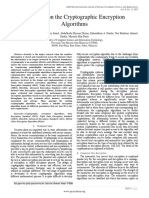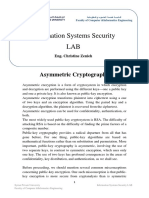Assymetric Cryptography
Assymetric Cryptography
Uploaded by
Misa PerisicCopyright:
Available Formats
Assymetric Cryptography
Assymetric Cryptography
Uploaded by
Misa PerisicOriginal Title
Copyright
Available Formats
Share this document
Did you find this document useful?
Is this content inappropriate?
Copyright:
Available Formats
Assymetric Cryptography
Assymetric Cryptography
Uploaded by
Misa PerisicCopyright:
Available Formats
Asymmetric cryptography, also known as public-key cryptography, revolutionized the
field of secure communication by introducing a groundbreaking concept: the use of
two distinct keys for encryption and decryption. Unlike symmetric cryptography,
where the same key is used for both encryption and decryption, asymmetric
cryptography employs a pair of mathematically related keys—a public key and a
private key.
The core principle behind asymmetric cryptography relies on the complexity of
certain mathematical problems, such as factoring large numbers or computing
discrete logarithms, which are computationally challenging and time-consuming to
solve. This complexity forms the foundation for creating cryptographic systems that
provide secure communication channels.
The keys in asymmetric cryptography are generated as a matched pair: the public key
and the private key. The public key is made available to anyone who wishes to
communicate securely with the owner of the key. It can be freely distributed and is
used to encrypt messages intended for the key owner. The private key, on the other
hand, is kept secret and known only to the key owner. It is used to decrypt
messages encrypted with the corresponding public key.
The encryption process involves using the recipient's public key to encode a
message, which can only be decrypted by the recipient's corresponding private key.
Conversely, a digital signature is created by using the sender's private key,
allowing anyone with access to the sender's public key to verify the authenticity
of the message.
Asymmetric cryptography addresses several critical security concerns:
Key Distribution: Asymmetric cryptography eliminates the need for secure key
exchange, which is a challenge in symmetric cryptography. Anyone can encrypt a
message using the recipient's public key, ensuring secure communication without the
need for a prior key exchange.
Digital Signatures: The use of private keys to create digital signatures allows for
message authentication, ensuring that the message originated from the claimed
sender and was not altered during transmission.
Secure Communication: Asymmetric cryptography provides a foundation for secure
communication over insecure channels, enabling confidentiality, authenticity, and
integrity in data exchange.
Despite its numerous advantages, asymmetric cryptography also has limitations and
challenges:
Computational Overhead: Asymmetric algorithms are more computationally intensive
compared to symmetric ones, making them less suitable for encrypting large volumes
of data.
Key Management: The secure storage and management of private keys are crucial. Any
compromise of the private key can compromise the entire security infrastructure.
Trust Issues: The authenticity of public keys must be ensured to prevent man-in-
the-middle attacks where a malicious actor intercepts and alters communication by
replacing public keys.
Asymmetric cryptography forms the backbone of secure communication in various
domains, including online transactions, digital signatures, secure email
communication, and secure browsing. The security it provides, coupled with its
ability to solve key distribution challenges, makes it a cornerstone of modern
cryptography. Ongoing advancements in cryptographic algorithms and protocols
continue to enhance the efficiency and security of asymmetric cryptography,
ensuring its relevance and continued use in the digital age.
You might also like
- Lesson Plan in Cookery 10 Cooking Methods of Vegetable DishesDocument2 pagesLesson Plan in Cookery 10 Cooking Methods of Vegetable DishesRechell Ellana Montierro50% (2)
- Training Officer S Tear Gas Blue BookDocument23 pagesTraining Officer S Tear Gas Blue Bookbpsat100% (2)
- CryptographyDocument15 pagesCryptographyQADEER AHMADNo ratings yet
- CryptologyDocument6 pagesCryptologyfs47No ratings yet
- CC Unit5 FinalDocument7 pagesCC Unit5 Finalsameer shaikNo ratings yet
- Assymetric EncrptionDocument2 pagesAssymetric Encrptionomssharma7042No ratings yet
- CNS Notes 1 & 2Document35 pagesCNS Notes 1 & 2raghatateharshal4No ratings yet
- Hybrid CryptographDocument8 pagesHybrid CryptographCao ThủNo ratings yet
- IS AssignmentDocument24 pagesIS Assignmentyuvanpgr-wm20No ratings yet
- unit-2 (1)Document80 pagesunit-2 (1)priyanka.singhNo ratings yet
- Cryptography and Network SecurityDocument8 pagesCryptography and Network SecurityPratham RaiNo ratings yet
- Maths cryptography Board practical Maths CBSEDocument11 pagesMaths cryptography Board practical Maths CBSESjjjx SihcyuNo ratings yet
- CryptosystemsDocument5 pagesCryptosystemsAnasham TegegnNo ratings yet
- FoQ Unit 4Document22 pagesFoQ Unit 4ongbro1224No ratings yet
- Unit 2-1Document45 pagesUnit 2-1suryarjun23No ratings yet
- Term PaperDocument5 pagesTerm PaperSai Teja UppuluriNo ratings yet
- 01 pp1 7 MattBlumenthal PDFDocument7 pages01 pp1 7 MattBlumenthal PDFandy lastNo ratings yet
- Cryptography: Latika Arora, IT/06/321Document5 pagesCryptography: Latika Arora, IT/06/321Yatish TagraNo ratings yet
- Cryptography 1Document4 pagesCryptography 1timothyokpalao9No ratings yet
- Cryptography in The Banking IndustryDocument8 pagesCryptography in The Banking IndustryArpan KarNo ratings yet
- CryptographyDocument7 pagesCryptographyZonia NillNo ratings yet
- Electronic Commerce UNIT - IIIDocument9 pagesElectronic Commerce UNIT - IIINIRMAL KNo ratings yet
- Document 6Document20 pagesDocument 6BCS20-204 AroojNo ratings yet
- Cryptography MaterialDocument46 pagesCryptography Materialmrsuhailv3No ratings yet
- UNIT 2 tkDocument4 pagesUNIT 2 tk12 Swastika Siddhi Ashok WaghNo ratings yet
- SohaiDocument16 pagesSohaiJHON ANDREI SEMANo ratings yet
- Network Security & Cryptography - Unit-1Document11 pagesNetwork Security & Cryptography - Unit-1Chandrapriya RediexNo ratings yet
- Cryptography & Network SecurityDocument5 pagesCryptography & Network SecurityAlok ShuklaNo ratings yet
- Context of Cryptography: ConfidentialityDocument13 pagesContext of Cryptography: ConfidentialityAnay ShrivastavaNo ratings yet
- CryptographyDocument7 pagesCryptographySameer KumthekarNo ratings yet
- Public KeyDocument15 pagesPublic KeytortoigalNo ratings yet
- 3.5.1 Asymmetric Keys and Encryption MethodsDocument5 pages3.5.1 Asymmetric Keys and Encryption MethodsNashit BudhwaniNo ratings yet
- E-Com Assignment 1Document3 pagesE-Com Assignment 1Hà Vy NguyễnNo ratings yet
- Unit-1 - Part - 2Document8 pagesUnit-1 - Part - 2shaikharmanazmi30No ratings yet
- Networks Internet E-Commerce Mobile Telephones Wireless Microphones Wireless Intercom Bluetooth Automatic Teller MachinesDocument6 pagesNetworks Internet E-Commerce Mobile Telephones Wireless Microphones Wireless Intercom Bluetooth Automatic Teller MachinessufiyanamujawarNo ratings yet
- Paper 41-A Survey On The Cryptographic Encryption AlgorithmsDocument12 pagesPaper 41-A Survey On The Cryptographic Encryption Algorithmsmcselles100% (1)
- Section C Lecture 1Document17 pagesSection C Lecture 1Anushka NigamNo ratings yet
- Cryptography_and_its_TypesDocument2 pagesCryptography_and_its_Types2648mannaNo ratings yet
- Unit III .IV Notes Cyber SecurityDocument87 pagesUnit III .IV Notes Cyber Securitymercy mNo ratings yet
- CryptographyDocument5 pagesCryptographyShivam SonkarNo ratings yet
- Cryptography PPTMDocument10 pagesCryptography PPTMIndraja PonnuNo ratings yet
- Lecture 1.1 Introduction Cryptography-UpdatedDocument7 pagesLecture 1.1 Introduction Cryptography-UpdatedNurdin YussufNo ratings yet
- Crtpto 5Document3 pagesCrtpto 5megha.garg1No ratings yet
- Information Systems Security LAB: Asymmetric CryptographyDocument11 pagesInformation Systems Security LAB: Asymmetric CryptographyAbdullah Al-HallakNo ratings yet
- Cyber NotesDocument33 pagesCyber NotesHarsh SinghalNo ratings yet
- Cryptography NotesDocument267 pagesCryptography NotesSusmitNo ratings yet
- Info SecDocument6 pagesInfo SecAamna SeeratNo ratings yet
- Md Akbarali Mobdal_L54_CA2 2Document5 pagesMd Akbarali Mobdal_L54_CA2 2mondalakbarali7No ratings yet
- Chapter 5 Authentication and Encryption TechnologyDocument34 pagesChapter 5 Authentication and Encryption TechnologyHasniza HarunNo ratings yet
- Networksecurity & Cryptography: Bandari Srinivas Institute of TechnologyDocument10 pagesNetworksecurity & Cryptography: Bandari Srinivas Institute of TechnologyGirish Kumar DamodaranNo ratings yet
- Data Encryption DecryptionDocument60 pagesData Encryption DecryptionMohit Sharma100% (2)
- Blockchain Technology NotesDocument44 pagesBlockchain Technology NotesShraddhey Satpute100% (1)
- IT-801 Information Security Lab FileDocument47 pagesIT-801 Information Security Lab Filesai thesisNo ratings yet
- Public Key Distribution The Foundation of Secure CommunicationDocument9 pagesPublic Key Distribution The Foundation of Secure CommunicationVaibhavi PanchalNo ratings yet
- U2Document19 pagesU2ronis27647No ratings yet
- Unit 1Document6 pagesUnit 1Gulshan ChaudhariNo ratings yet
- AssignmentDocument3 pagesAssignmentAyeshaNo ratings yet
- Module (Code &Name:Swdba401-Backend Application DevelopmentDocument62 pagesModule (Code &Name:Swdba401-Backend Application Developmentmuganzajesus001No ratings yet
- ENCRYPTION upload file 3Document4 pagesENCRYPTION upload file 3Chenthil Kumar KNo ratings yet
- network securityDocument3 pagesnetwork securitypriyagowda5542No ratings yet
- Presentado Por: Karoll Mishell Fragozo Ramirez Maria Elena Rangel Yefferson Javier Quintero Cristian Daid Parra Daniel Pabon Yeiman RomeroDocument52 pagesPresentado Por: Karoll Mishell Fragozo Ramirez Maria Elena Rangel Yefferson Javier Quintero Cristian Daid Parra Daniel Pabon Yeiman RomeroYeffersonNo ratings yet
- 50f55d56-3aa0-4f96-a6d4-7d58cfbfe6f8Document4 pages50f55d56-3aa0-4f96-a6d4-7d58cfbfe6f8Richard BakerNo ratings yet
- Exercise Project ManagementDocument19 pagesExercise Project ManagementstormspiritlcNo ratings yet
- Course Guide: New Masters AcademyDocument23 pagesCourse Guide: New Masters AcademyleonNo ratings yet
- Chromatography Theory & PrinciplesDocument68 pagesChromatography Theory & PrinciplesShayne DeeNo ratings yet
- Gastritis: Free TemplatesDocument57 pagesGastritis: Free TemplatesJonathanNo ratings yet
- Instant Download Scanning Electron Microscopy For The Life Sciences 1st Edition Heide Schatten PHD PDF All ChapterDocument84 pagesInstant Download Scanning Electron Microscopy For The Life Sciences 1st Edition Heide Schatten PHD PDF All Chapterkedamobaskan100% (11)
- Filmes Finos & Revelação de Impressões Digitais Latentes: Dia Mundial Dos Materiais 2009 Prémio Ordem Dos EngenheirosDocument19 pagesFilmes Finos & Revelação de Impressões Digitais Latentes: Dia Mundial Dos Materiais 2009 Prémio Ordem Dos EngenheirosCésar Santos SilvaNo ratings yet
- Lab Report 2Document12 pagesLab Report 2Fatihah AlhataNo ratings yet
- Scanning Electron Microscopy and X-Ray Microanalysis: Book ReviewDocument1 pageScanning Electron Microscopy and X-Ray Microanalysis: Book Review平No ratings yet
- CHM571-1.PDFDocument5 pagesCHM571-1.PDF2022841642No ratings yet
- ING Quotation RetailDocument42 pagesING Quotation RetailJulija VasiliauskaitėNo ratings yet
- FL52337 Ftir Spectrometer Selection Guide MinDocument2 pagesFL52337 Ftir Spectrometer Selection Guide Minmouhssine.sallamiNo ratings yet
- Methods of Purification of Organic CompoundsDocument9 pagesMethods of Purification of Organic CompoundsTolani AyoNo ratings yet
- Fishing SuppliesDocument5 pagesFishing SuppliesThu Ha TranNo ratings yet
- Chef Mehernosh Dhanda: 1 BAC 101 Culinary Foundation Level 1 6/2/2019Document31 pagesChef Mehernosh Dhanda: 1 BAC 101 Culinary Foundation Level 1 6/2/2019riza belonioNo ratings yet
- Plantilla PowerPoint de Fiestas Patrias MexicoDocument58 pagesPlantilla PowerPoint de Fiestas Patrias Mexicoelena marinNo ratings yet
- Glossary of Fingerprint TermsDocument4 pagesGlossary of Fingerprint Termsroncarl29No ratings yet
- Public Key Cryptography ExplainedDocument2 pagesPublic Key Cryptography ExplainedAndreas LarssonNo ratings yet
- CholecalciferolDocument2 pagesCholecalciferolgrace_febiantyNo ratings yet
- Craftool Conversion ChartDocument8 pagesCraftool Conversion ChartkleponojitchiNo ratings yet
- Forensic IdentifyDocument4 pagesForensic IdentifyalexademileighpacalNo ratings yet
- Online Webinar PowerPoint Templates (Autosaved)Document48 pagesOnline Webinar PowerPoint Templates (Autosaved)wandy RJNo ratings yet
- NPCP Abstract Card 2022Document13 pagesNPCP Abstract Card 2022Kieron Ivan M. GutierrezNo ratings yet
- 15 Different Methods of Cooking You Should Know: Ms. Jam OrenciadaDocument32 pages15 Different Methods of Cooking You Should Know: Ms. Jam OrenciadaJamil OrenciadaNo ratings yet
- 02 Cryptographic ToolsDocument116 pages02 Cryptographic ToolsMoh Abdul Rehman MustafaNo ratings yet
- Wood Engraving - WikipediaDocument29 pagesWood Engraving - WikipediaLKMs HUBNo ratings yet
- SMA CONS WIN 02 - ScaffoldingDocument25 pagesSMA CONS WIN 02 - ScaffoldingReyfaldyNo ratings yet

























































































